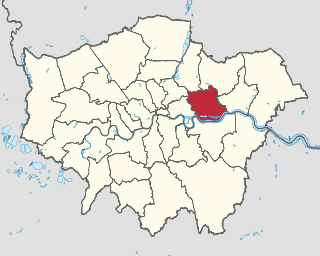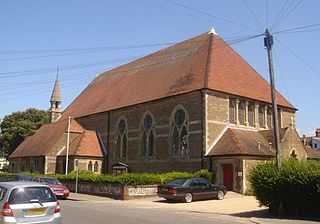
The London Borough of Newham is a London borough created in 1965 by the London Government Act 1963. It covers an area previously administered by the Essex county boroughs of West Ham and East Ham, authorities that were both abolished by the same act. The name Newham reflects its creation and combines the compass points of the old borough names. Situated in the Inner London part of East London, Newham has a population of 387,576, which is the third highest of the London boroughs and also makes it the 16th most populous district in England. The local authority is Newham London Borough Council.

St John the Evangelist is an Anglican church on Friern Barnet Road in north London. It is a late example of the Gothic Revival Style by Victorian architect John Loughborough Pearson, begun in 1890-91 and completed after his death by his son Frank Loughborough Pearson.

St George's Church is an Anglican church in the East Worthing area of the borough of Worthing, one of seven local government districts in the English county of West Sussex. Built in 1867–68 to serve new residential development in the southeast of the town, the Decorated Gothic-style structure was extended later in the 19th century, and expanded its reach further by founding three mission halls elsewhere in Worthing. English Heritage has listed it at Grade C for its architectural and historical importance.

St Philip and St James’ Church is a Church of England church in Plaistow, east London. It originated as two churches before being merged into the joint parish of St Philip and St James in 1955. That parish in its turn has now become part of the Parish of the Divine Compassion along with three other parishes in Plaistow and Canning Town - St Mary's, St Matthias' and St Martin's.
St John the Baptist's Church, East Ham, was a Church of England church dedicated to St John the Baptist in East Ham, east London. It was built in 1866 as a chapel of ease to St Mary Magdalene's Church, then still the main parish church for the area. In 1902 it was converted into a church hall for the new church of St Bartholomew's and in 1925 it was demolished.

St Bartholomew's Church, East Ham is a Church of England church on Barking Road in East Ham, east London dedicated to Bartholomew the Apostle.
St Michael and All Angels Church, Beckton Road, was a Church of England church in East Ham, east London. It opened as a mission of St Mary Magdalene's Church, East Ham in 1883 and immediately rebuilt after burning down three years later. A permanent church was built on a new site around 1906, funded by the Gas Light and Coke Company. A new mission district was formed for it about 1922, but the church was not rebuilt after bombing in 1941 during the London Blitz and ultimately the district was dissolved in 1952, to be merged back into St Mary's parish. St Michael's had also founded two mission churches of its own, St Mark's, Ferndale Street (c.1890) and St Andrew's, Roman Road (1934) - these both closed in 1952 when the district was dissolved.

St George and St Ethelbert's Church, East Ham, is a Church of England church in East Ham, east London.
All Saints Church, East Ham is a Church of England church in East Ham, east London. It was set up around 1880 in an iron mission church to meet the development of the Woodgrange Estate. This was replaced by a parish of its own with a permanent church in the Early English style on Romford Road in 1886.

St Edmund's Church, Forest Gate or the Church of St Edmund, King and Martyr, Forest Gate is an Anglo-Catholic church in the Forest Gate area of Newham, east London. It is dedicated to Edmund the Martyr. It originated in 1895 as the Red Post Lane mission district of All Saints parish. It became a parish of its own in 1901, with a permanent church completed in 1932. It now forms part of the East Ham Team Parish alongside St Mary Magdalene's Church, St Bartholomew's Church and St Alban's Church.
St Stephen's Church, East Ham, was a church on Green Street in East Ham, east London. Its nave and aisles were completed in 1887 and its chancel, north chapel, south chancel aisle, vestries and choir in 1894. It founded three mission churches - St Alban's Church, St Michael's Church, Rutland Road and St Cuthbert's Church, Florence Road.
St Alban's Church, Upton Park is a Church of England church in the Upton Park area of East Ham in east London, England, dedicated to Saint Alban. It was founded by St Stephen's Church as a mission church on Boleyn Road in the Upton Park area around 1889, replaced by a small brick church on Wakefield Street in 1897. It was given a parish of its own in 1903, in which year the nave and aisle of a new permanent church on the opposite side of the same street were completed. Vestries, a Lady Chapel and chancel were added in 1934. Damaged by the London Blitz in 1940, it was repaired in 1949 and now forms part of the East Ham Team Parish alongside St Mary Magdalene's Church, St Bartholomew's Church and St Edmund's Church.
St Michael's Church, Rutland Road is a church in East Ham, east London, originally built for the Church of England. It was established as a mission church of St Stephen's Church, East Ham in 1895, with services held in Saxby Villas, Red Post Lane until the completion of a temporary iron church in 1898. In 1912 a permanent church was built. This housed the congregation of St Stephen's after that church was damaged by bombing in 1940 and after that parish was dissolved in 1953 St Michael's was instead attached to St Edmund's Church. It closed as an Anglican church in 1971 and now houses a Romanian Orthodox church.

The Church of the Ascension, West Ham, or Church of the Ascension, Victoria Docks, is a Church of England church on Baxter Road in West Ham, east London. It was first built in 1887 as a mission hall for St Luke's Church, later put under the charge of the Felsted School Mission, which prior to that had been working in Bromley. Between 1903 and 1907 a new church was built, with a separate parish split from St Luke's in 1905. The new parish opened a mission house for women workers in 1909.

St Luke's Church, Canning Town or St Luke's Church, Victoria Docks is a Church of England church, originally housed in a building on Boyd Road in the Royal Docks area of West Ham in east London.

St Paul's Church, Stratford is a Church of England church in Stratford, London. It had its origins in a Sunday School opened in Stratford New Town by a City Missionary around 1850, for which a building was constructed on Queen Street by Samuel Gurney in 1853, within the parish of St John's Church, Stratford. St John's vicar William Holloway was ambivalent about the mission and so friction arose when the vicar of All Saints, A J Ram, bought a site for the mission to build a church, initially an iron hall in 1859 and a permanent church in 1864, both dedicated to St Paul. The latter was built with assistance from Thomas Fowell Buxton and Raymond Pelly. The permanent church was then assigned a separate parish in 1865, split from that of St John's. The church was destroyed by a V-weapon in 1945, but was replaced by a new building, consecrated in 1953.

St Andrew's Church was a Church of England church on Barking Road in Plaistow, east London. It began as a small mission built in 1860 on Whitwell Road by St Mary's Church, Plaistow. A permanent church designed by James Brooks opened in 1870 on a site just south of the northern outfall sewer embankment and a separate parish assigned to it the following year. A large central crossing tower with a pyramidal spire was planned but only completed as far as the ridge of the nave roof.
St Saviour's Church is a Church of England church in Forest Gate, east London. It was opened by Emmanuel Church, Forest Gate as a mission hall in 1880, with a separate parish and a permanent church following three years later. Its first vicar was Henderson Burnside, one of the first Anglican missionaries in Japan. It opened a mission at "365 Railway Arches" in 1903. Its parish is now known as 'St Saviour's and St James's, Forest Gate' after the area formerly forming the parish of St James' Church, Forest Gate was transferred to it in 2014 - the congregation from St James', however, transferred to St Paul's Church, Stratford, also in 2014.
St Barnabas' Church, West Silvertown was a Church of England church in Silvertown, east London. It was opened in 1882 on Eastwood Road as a mission church of St Mark's Church, Silvertown. In the 1917 Silvertown explosion its chancel and iron hall were destroyed, leaving the church to use temporary buildings until the completion of a new church and the formation of a separate parish for it, both in 1926. The new parish was mainly drawn from St Mark's, though it also took a small part of the parish of St Luke's Church, Canning Town. The vicar of St John's Church, North Woolwich administered it after 1945. The parishes of St John, St Mark and St Barnabas were merged in 1974 to form the parish of North Woolwich with Silvertown.

St Barnabas' Church, Woodford Green, is a Church of England church in Snakes Lane East, Woodford, London. It had its origins in a 1904 iron mission church – this was attached to St Paul's Church, Woodford. A permanent church was built between 1910 and 1911, with a lady chapel, organ chamber, chancel and two bays of an aisled nave – the nave was completed in 1964. The church was designed by E T Dunn, who also designed St Luke's Church, Ilford, and produced a proposed design for a new chapel screen at St Peter's Church, Bethnal Green. Parts of the parishes of St Paul's, All Saints Church, Woodford Wells, and Holy Trinity Church, South Woodford, were combined to form the new parish of St Barnabas in 1911.












